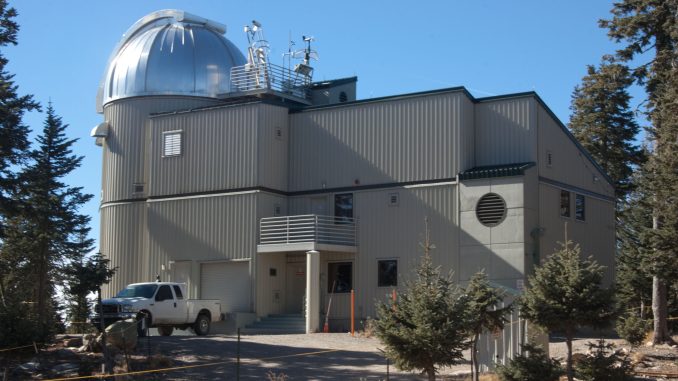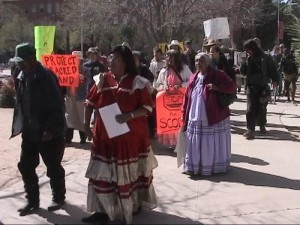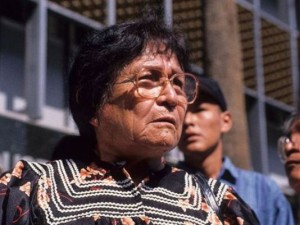
Back in 2010, the University of Arizona, together with the Vatican and Jesuit Order,
Catholic church
announced today it named its newest high-powered telescopic instrument ‘Lucifer’.
There has been a great deal of speculation, among
Vatican
critics, why in the first place the Jesuit Order was allowed to build a huge stellar observatory on Mt. Graham in Arizona – on holy Indian ground – in cooperation with the state-run University of Arizona.
With the naming of Lucifer, critics claim the Vatican has showed its true colors, using God and Jesus as shills for their true master — Lucifer.
According to an article in Popular Science by Rebecca Boyle the “new instrument with an evil-sounding name is helping scientists see how stars are born.”
The article went to explain the name Lucifer stands for (deep breath) “Large Binocular Telescope Near-infrared Utility with Camera and Integral Field Unit for Extragalactic Research.”
The
catholic church
worships “religion and science.” (It’s stated so in their own annual report 2014.)
Celestial Telescopes: “And yes,” according to Popular Science, “it is named for the Devil, whose name itself means “morning star.”
However, according to a spokesman for the University of Arizona, it wasn’t meant to evoke any connotations of evil. (Are you serious?)
Lucifer has three interchangeable cameras for imaging and spectroscopy in different resolutions. It has a large field of view and high-res capabilities, which allow a wide range of observations.
Critics are now shaking their heads even more, wondering why the Vatican would have its own stellar observatory and why they would have the audacity to name a new telescope after the Devil himself.
According to Mitch Battros some people believe “it is for the purpose to monitor a warning presented in the Bible. What exactly is that “warning” they’re looking for?
Could it be it is named “Wormwood” coming from the New Testament book of Revelation, saying:
“And the third angel sounded, and there fell a great star from heaven, burning as it were a lamp, and it fell upon the third part of the rivers, and upon the fountains of waters; And the name of the star is called Wormwood: and the third part of the waters became wormwood; and many men died of the waters, because they were made bitter.” (Revelation 8:10, 11 – King James Bible).
Battros added this reference to the end times as well as Mayan prophecy:
“Is it possible the Vatican has the same information as the Mayans? Both speak of an event coming from the center of our galaxy Milky Way. Both indicate a powerful celestial event. But the most important question of all is “when.”
“I do not believe any scientist or focused individual can argue that all of space science and cosmology appears to have a certain urgency for discovery. From galactic ‘charged particles’ to new found asteroids, there is a sense of ‘let’s find it as soon as we can’.”
Here is an article that appeared in the Native American Roots web site, explaining how the Vatican violated Native American holy ground:
For many Native American nations there are certain geographic places which have special spiritual meanings. These sacred places are often “portals” to the spirit worlds. For the Apache in Arizona, one of these sacred places is Mount Graham: this place is called Dzil Nchaa Si An (Big Seated Mountain) and is mentioned in 32 of the sacred songs which have been handed down through the oral tradition for many generations. It is here that the Ga’an, the guardian spirits of the Apache, live.
In 1873, Mount Graham was removed from the boundaries of the San Carlos Reservation and placed in public domain. The spiritual value of Mount Graham to the Apache was not considered. This action set the stage for conflict a century later.
 In 1984, the University of Arizona and the Vatican selected Mount Graham as a site for a complex of 18 telescopes. The fact that this is a sacred place for the Apache was not taken into consideration. To get around the legal barriers of the American Indian Religious Freedoms Act, the University hired a lobbying firm to put pressure on Congress to remove this, and other, roadblocks. The area in question is administered by the U.S. Forest Service.
In 1984, the University of Arizona and the Vatican selected Mount Graham as a site for a complex of 18 telescopes. The fact that this is a sacred place for the Apache was not taken into consideration. To get around the legal barriers of the American Indian Religious Freedoms Act, the University hired a lobbying firm to put pressure on Congress to remove this, and other, roadblocks. The area in question is administered by the U.S. Forest Service.
The Vatican has an observatory staff which is officially support by the Vatican City State. The Vatican Observatory Foundation is supported by private donations. One of the important duties of the church is to maintain an accurate calendar and this requires astronomical observations. Hence the involvement of the Vatican with astronomy. The first Vatican observatory was established in 1774.
Congress passed the Arizona-Idaho Conservation Act in 1988. In response to lobbying by the University of Arizona and the Vatican, the Act included a provision to allow the construction of three telescopes on Mount Graham without having to comply with the American Indian Religious Freedoms Act or with environmental laws.
The following year the Apache Survival Coalition was started by Ola Cassadore-Davis, the daughter of Apache spiritual leader Phillip Cassadore. The purpose of the Coalition was to save Dzil Nchaa Si An from desecration by a telescope complex to be built by the University of Arizona and the Vatican.
In 1991, the San Carlos Apache Tribe passed a resolution stating that Mount Graham is sacred to them. Furthermore, the resolution stated that the tribe supported the efforts of the Apache Survival Coalition to protect the religious and cultural beliefs of the tribe.
Following the declarations of the sacredness of Mount Graham by the Apache Survival Coalition and the San Carlos Apache Tribe, the Vatican in 1991 declared that Mt. Graham was not sacred because it lacked religious shrines.
Jesuit Father George Coyne, director of the Vatican Observatory, indicated that he could not find an authentic Apache who thought the mountain was sacred. Father Coyne stated that to convince him that the mountain was sacred he would need to see evidence of shrines and that he would not accept Apache oral history or statements by Apache-speaking Euro-American anthropologists.
Father Coyne further declared that Apache beliefs were “a kind of religiosity to which I cannot subscribe and which must be suppressed with all the force we can muster.”
The Arizona Republic (Phoenix, Arizona) reports that the Jesuit Father Charles W. Polzer calls opposition to the construction of the telescope complex on top of Mount Graham “part of a Jewish conspiracy” and comes from the Jewish lawyers of the American Civil Liberties Union who are out to undermine and destroy the Catholic Church.
In spite of opposition by the San Carlos Apache tribal council, Apache spiritual leaders, and environmental groups, actual construction of the project began in 1991.
With flagrant insensitivity to American Indians, the University of Arizona announced that it intended to name its new telescope on Mount Graham the Columbus telescope in honor of the European explorer. The University was apparently unaware that Columbus is not considered to be a hero by American Indian people. Ultimately, the University withdrew the name following public response against it.
The San Carlos Apache tribal council in 1993 reaffirmed resolutions opposing the construction of the telescope on Mount Graham. The council resolution stated that the telescope “constitutes a display of profound disrespect for a cherished feature of our original homeland as well as a serious violation of our traditional religious beliefs.”
After meeting with Apache elders and spiritual leaders at the San Carlos Apache Reservation, the National Council of Churches in 1995 passed a resolution calling for the removal of a telescope from Mount Graham.
The President’s Advisory Council on Historic Preservation in 1996 declared the entire Mount Graham observatory project to be in violation of the National Historic Preservation Act because of the project’s harm to Apache culture and spiritual life, but the telescope was not removed.
In 1997, the spokesman for the Apaches for Cultural Preservation was arrested for praying on Mount Graham. The Apaches for Cultural Preservation feel that the Forest Service, the University of Arizona, and the Vatican developed the project on Mount Graham knowing that it would violate Apache religious beliefs.
President Bill Clinton, using the line item veto, deleted $10 million in federal funds for the operation of the University of Arizona’s Mount Graham telescope project. San Carlos Apache Chairman Raymond Stanley and the White Mountain Apache Cultural Resources Director Ramon Riley sent letters to the President thanking him for the veto.
Beginning in 1998, the University of Arizona began requiring Indians to obtain prayer permits before they crossed the top of Mount Graham near the University’s telescopes.
The University’s prayer policy required that the permit be requested at least two business days before the visit and that it include a description of where on the mountain the prayers will take place. Only people who were enrolled members of federally recognized tribes were allowed to pray.
In 1999, the University of Notre Dame, a Catholic university, announced that it would also build a telescope on Mount Graham. The University president claimed that he was unaware that Mount Graham was sacred to the Apache and that the Apache opposed the desecration of this sacred place. This was in spite of the fact that the building of telescopes on this sacred mountain by the University of Arizona and the Vatican was a controversial issue and had been the subject of many news stories.
In 1999, the White Mountain Apache tribal council passed a resolution urging the U.S. Forest Service to “honor its duties to protect the physical integrity of Mount Graham and its long-standing and ongoing historical, cultural and religious importance to many Apaches.”
Realizing that they were making little headway with the bureaucracies of the American government (Department of the Interior and Department of Agriculture) and Congress, the Apaches took their cause to the United Nations in 1999.
 Ola Cassadore Davis testified before the Sub-Commission on Prevention of Discrimination and Protection of Minorities. She stated: We Apache wish to bring to the people of this world a better understanding of Indian people, in order that we are able to preserve and freely live by our traditional culture and religious beliefs.
Ola Cassadore Davis testified before the Sub-Commission on Prevention of Discrimination and Protection of Minorities. She stated: We Apache wish to bring to the people of this world a better understanding of Indian people, in order that we are able to preserve and freely live by our traditional culture and religious beliefs.
Four years later, Vatican scientists co-host conference on alien life forms. Nearly 200 scientists are attending the conference, called The Search for Life Beyond the Solar System: Exoplanets, Biosignature & Instruments, which runs from March 16-21 in Tucson, Arizona. The Vatican Observatory is co-hosting the conference with the University of Arizona’s Steward Observatory.
‘Finding life beyond Earth is one of the great challenges of modern science and we are excited to have the world leaders in this field together in Tucson,’ said event co-chair Daniel Apai, assistant professor of astronomy and planetary sciences at the UA Steward Observatory.
‘But reaching such an ambitious goal takes planning and time. The goal of this meeting is to discuss how we can find life among the stars within the next two decades.’
The Rev Paul Gabor of the Vatican Observatory, the conference’s other co-chair, added that scientists will give more than 160 research presentations during this week’s conference.
According to the organizers, the conference will cover the technical challenges of finding and imaging exoplanets and identifying bio signatures in the atmospheres of far-flung worlds. Other presentations will discuss the study of life forms that live in extreme environments on Earth, which could be apt analogs for life on other planets.
The Vatican Observatory is one of the oldest active astronomical observatories in the world, with its roots going back to 1582 and the reform of the Julian calendar. Papal interest in astronomy can be traced to Pope Gregory XIII who had the Tower of the Winds built in the Vatican in 1578 The observatory in its present form was officially founded in 1891 by Pope Leo XIII. Today there are 13 Jesuits from 6 countries throughout the world on staff of the Observatory.
The Vatican and catholic church are neck high in idolatry and apostasy, so, is it any wonder that they are looking for “aliens?”
Original article By Greg Szymanski, JD



Pope Gregory XIII bestowed on the ‘Company of Jesus’ (The Jesuits) the right to deal in banking and commerce.A right it made use of extensively later on. Edmond Paris The secret history of the jesuits.
Lucifer is the only thing sacred to these creatures.